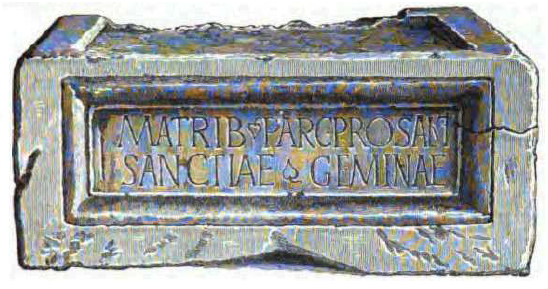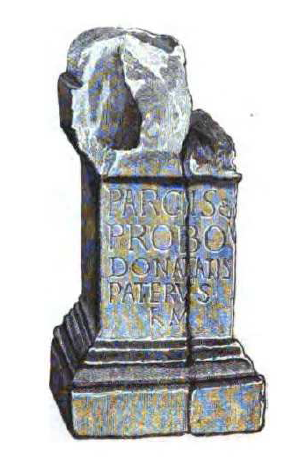B) Roman Parcae/Fatae
The ‘Mothers’ are also equated with the Roman Parcae, Fatae or Fatae. Two dedications from Britain exemplify this connection. The first one was found on the shore at Skinburness, near Silloth (Cumbria): Matribu[s] Par(cis) […], ‘To the Mothers the Fatae’,457 and the other in Carlisle (Cumbria): Matrib(us) Parc(is) pro salut(e) Sanctiae Geminae, ‘To the Mother Goddesses, the Fatae, for the welfare of Sanctia Gemina’ (fig. 19).458 Another noteworthy example is that of the Matronae Dervonnae ‘Mother Goddesses of the Oak’, venerated in Milan (Italy): Matronis Dervonnis C(aius) Rufinus Apronius vslm, ‘To the Matronae Dervonnae, C(aius) Rufinus Apronius paid his vow willingly and deservedly’,459 who are given the title of Fatae in an inscription from Brescia (Italy): Fatis Dervonibus vslm M(arcus) Rufinius Severus, ‘To the Fatae Dervonnae Marcus Rufinus Severus paid his vow willingly and deservedly’.460 This example shows that the terms Matronae and Fatae are connected with one another and that the ‘Mothers’ were believed to share some of the functions of the Roman female deities.

The Parcae are the late triple representation of the Roman goddess Parca, who originally presided over childbirth and destinies.461Her name may come from the Latin verb pario, ‘to give birth’ or ‘to produce’ (for the earth).462 The Fatae, from Latin fātum (‘oracle, prediction’; ‘fate’, ‘destiny’ ; ‘life-time’, inducing death; ‘fatality’, ‘unfortune’), or Parcae (‘Those who bring forth the child’) are the Roman counterparts of the Greek Moirai (Μοĩραι), whose name, generally translated as ‘Cutters-off’ or ‘Allotters’, can be related to Greek moira designating the ‘part’, the ‘share’, the ‘portion’ and to Greek móros referring to ‘lot’ or ‘fate’, with the idea of dispensing good as well as bad.463 They are generally represented as three female deities, called the Tria Fata (‘the Three Destinies’), for they supervise and embody the destiny of humankind from birth to death.464 While Nona (‘Ninth’), the equivalent of Greek Klotho (‘Spinner’), spins the web of life with her distaff and presides over childbirth, Decima (‘Tenth’), who is similar to Greek Lakhesis (‘the Drawing of Lots’), protects marriage and holds the thread of life i.e. dispenses fate. The third one, Morta (‘Death’), the equivalent of the Greek Atropos (‘Inevitable’ or ‘Unchangeable One’), cuts the thread of life and symbolizes death.465
The Parcae or Fatae are honoured on their own in many inscriptions from Britain, such as in Carlisle (Cumbria): Parcis Probo Donatalis pater v.s.l.m., ‘To the Fatae for Probus his father Donatalis gladly and deservedly fulfilled his vow’ (fig. 20);466 from Germany, such as in Wies-Oppenheim,467 Cologne468 and Cleves;469 and from Gaul, where they are principally represented in the Narbonese region, such as in Nîmes (Gard),470 Arles (Bouches-du-Rhône),471 Vaison-la-Romaine (Vaucluse),472 Orange (Vaucluse),473 Apt (Vaucluse),474 and Rians (Var).475

This concept of fate-women is also found in Norse mythology, in the mythical characters of the Nornes (Nornir), which generally appear three in number, especially in later medieval texts. A poem from around 1,000 AD, entitled the Vǫluspá (19-20) or ‘The Sybil's Prophecy’, which is comprised in the Edda, has them standing by the fountain of Urðr and watering the ash tree Yggdrasil to prevent it from withering.476 The poem is the following:
‘Ask veit ek standa, / heitir Yggdrasill, / hár baðmr, ausinn / hvíta auri; / þaðan koma dǫggvar / þærs í dala falla; / stendr æ yfir, grænn / Urðar brunni.Þaðan koma meyiar, / margs vitandi, / þriár, ór þeim sæ / er und þolli stendr; / Urð héto eina, / aðra Verðandi, / -skáro á skíði- / Skuld ina þriðio. / Þær lǫg lǫgðo, / þær líf kuro / alda bǫrnum, / ørlǫg seggia.477
I know an ash that stands / called Yggdrasill, / a tall tree, watered / with white silt; / from there comes the dew / which falls in the valleys; / it stands eternally, green / over the well of Urðr.
From there come maidens, / very knowledgeable, / three, from that lake / which stands under the tree; / one they called Urðr, / another Verðandi, / -they carved on slips of wood- / Skuld the third one. / They laid down laws, / they chose life / for the children of men, / the fate of men.478 ’
It seems that, originally, there was only one goddess embodying Fate: Urðr. In Old Norse, the noun urð means ‘fate’ when it is feminine and ‘death’ when it is masculine.479 It is cognate with Old German wurd and Old English wyrd, ‘destiny’. Under the Greco-Roman or Celtic influence, Urðr was later tripled and given two sisters bearing the names of Verðandi (‘happening, becoming, taking place now’), the present participle form of the Old Norse verb verða, ‘to become’, and Skuld (‘debt’ or ‘something owed’).480 On account of an etymological misinterpretation, medieval scholars translated their three names as ‘Past’ for Urðr, ‘Present’ for Verðandi and ‘Future’ for Skuld, certainly to justify and illustrate their functions as embodiment of Fate.481
It is generally accepted by scholars that the Old Norse texts describe the Nornir as spinners, holding and weaving the thread of human life in their hands, but Karen Bek-Pedersen has demonstrated in her thesis entitled Nornir in Old Norse Mythology that spinning-Nornir are actually never mentioned or alluded to in the original sources.482 This idea, which is generally taken for granted, must have arisen from the well-known characters of the Roman Parcae or Greek Moirai, who are clearly described as weavers of fate in the Classical texts.483 As this poem tells, the main function of the Nornir is to preside over the destiny of humankind and to apply the law of nature and fate to them: “They laid down laws, they chose life for the children of men, the fate of men”.484
In addition to being associated with the Parcae in the epigraphy, the Matres are also sometimes represented in the iconography as three women possessing some of their attributes, which are generally the spindle, the distaff and the scroll. Such is the case on the relief* found in Trier, which has three goddesses, holding a spindle, a cloth and a distaff (from right to left).485 The relief* from Metz is more dubious, for only a clumsy drawing of it remains.486 Nonetheless, it is worth noting that, of the three goddesses situated above a tree-faced head, the one on the left lifts a distaff in her left hand and holds a spindle in her right hand. Similarly, a relief* from Dannstadt represents a group of several goddesses: Victory, Maia, a goddess with a torch (Juno), and two draped goddesses, one of whom holds a bowl in her right hand and the other one a spindle in her left hand.487As for the relief* from Spire, it shows a goddess holding a ball of wool in her lap, which recalls the spinning of the Fatae.488 Finally, two bas-reliefs* discovered in Nuits-Saint-Georges (les Bolards), show a trio of goddesses, holding a baby, a patera*, as well as the beam of a pair of scales and a scroll or volumen.489These attributes, which are undoubtedly borrowed from the myth of the Roman Parcae, represent the power of the mothers over life and destiny. They are perceived as weavers of fate and prophetesses.